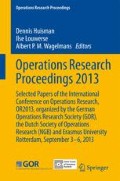Abstract
Indian banking has experienced exponential growth after reforms of 1990s that helped to improve the profitability, performance and efficiency. However, still there are conflicting concerns of operating efficiency and risk management across the major bank categories particularly after the global financial crisis. We have used Data Envelopment Analysis (DEA) for measuring the efficiency of a set of decision making units (DMUs) which traditionally assumes that all the input and output values are non-negative. Quantitative measures of bank performance like net profits, growth rates and default portfolios frequently show negative values for output variables. We draw motivation from some studies done in other developing countries for handling the negative data sets. We cross examine the approaches for dealing with variables that are positive for some DMUs and negative for others and test the validity of Range Directional Measure Model (RDM) for examining cases when some inputs and/or outputs can take negative as well as positive values. We find some support for the RDM in handling data negative sets without the need for any transformation (conversion of the negative values with small positive values) as a measure of efficiency akin to the radial measures in traditional DEA. Our preliminary investigation indicates no significant difference between the operational efficiency and profitability of public and private banks modeled for negative data and undesirable output.
Access this chapter
Tax calculation will be finalised at checkout
Purchases are for personal use only
References
Alirezaee, H., & van de Panne, C. (1998). Sampling size and efficiency bias in data envelopment analysis. Journal of Applied Mathematics and Decision Sciences, 21, 51–64.
Avkiran, N. K. (1999). An application reference for data envelopment analysis: Helping the novice researcher. International Journal of Bank Marketing, 17, 206–220.
Avkiran, N. K. (1999). The evidence on efficiency gains: The role of mergers and the benefits to the public. Journal Banking & Finance, 23, 991–1013.
Avkiran, N. K. (2000). Rising productivity of Australian trading banks under deregulation. Journal of Economics and Finance, 24, 122–140.
Berger, A. N., & Mester, L. J. (1997). Inside the black box: What explains differences in the efficiencies of financial institutions? Journal of Banking and Finance, 21, 895–947.
Bhattacharyya, A., & Kumbhakar, S. C. (1997). Changes in economic regime and productivity growth: A study of Indian public sector banks. Journal of Comparative Economics, 25, 196–219.
Bhattacharyya, A., Lovell, C. A. K., & Sahay, P. (1997). The impact of liberalisation on the productive efficiency of Indian commercial banks. European Journal of Operational Research, 98, 332–345.
Charnes, A., Cooper, W., & Rhoades, E. (1978). Measuring the efficiency of decision making units. European Journal of Operations Research, 2, 429–444.
Das, A., Nag, A., Ray, S.C. (2004). Liberalization, ownership, and efficiency in Indian banking: A nonparametric approach. Working Paper, Department of Economics, University of Connectcut.
Gilbert, R., & Wilson, P. (1998). Effects of deregulation on the productivity of Korean banks. Journal of Economics and Business, 50, 133–155.
Giokas, D. (1991). Bank branch operating efficiency: A comparative application of DEA and the log linear model. Omega, 19(6), 549–57.
Golany, B., & Storbeck, J. E. (1999). A data envelopment analysis of the operational efficiency of bank branches. Interfaces, 29(3), 14–26.
Kantor, J., & Maital, S. (1999). Measuring efficiency by product group: Integrating DEA with activity-based accounting in a large Mideast bank. Interfaces, 29(3), 27–36.
Leightner, J., & Lovell, C. (1998). The impact of financial liberalisation on the performance of Thai banks. Journal of Economics and Business, 50, 115–131.
Mukherjee, A., Nath, P., & Pal, M. N. (2002). Performance benchmarking and strategic homogeneity of Indian banks. International Journal of Bank Marketing, 20(3), 122–139.
Pastor, J., & Ruiz, J. (2007). Variables with negative values in DEA. In J. Zhu & W. Cook (Eds.), Modeling data irregularities and structural complexities in data envelopment analysis (pp. 63–84). Berlin: Springer.
Portela, M., Thanassoulis, E., & Simpson, G. (2004). A directional distance approach to deal with negative data in DEA. Journal of Operational Research Society, 55(10), 111–1121.
Saha, A., & Ravishankar, T. S. (2000). Rating of Indian commercial banks: A DEA approach. European Journal of Operations Research, 124, 187–203.
Sathye, M. (2001). X-efficiency in Australian banking: An empirical investigation. Journal of Banking and Finance, 25, 613–630.
Sathye, M. (2002). Measuring productivity changes in Australian banking: An application of Malmquist indices. Managerial Finance, 28, 48–59.
Sherman, D. H., & Gold, F. (1985). Bank branch operating efficiency: Evaluation with data envelopment analysis. Journal of Banking and Finance, 9(3), 297–315.
Sturm, J., Williams, B. (2002). Deregulation, entry of foreign banks and bank efficiency in Australia. CESifo Working Paper.
Tone, K. (2001). A slacks-based measure of efficiency in data envelopment analysis. European Journal of Operational Research, 130(3), 498–509.
Author information
Authors and Affiliations
Corresponding author
Editor information
Editors and Affiliations
Rights and permissions
Copyright information
© 2014 Springer International Publishing Switzerland
About this paper
Cite this paper
Gupta, P.K., Garg, S. (2014). DEA Modeling for Efficiency Optimization of Indian Banks with Negative Data Sets. In: Huisman, D., Louwerse, I., Wagelmans, A. (eds) Operations Research Proceedings 2013. Operations Research Proceedings. Springer, Cham. https://doi.org/10.1007/978-3-319-07001-8_23
Download citation
DOI: https://doi.org/10.1007/978-3-319-07001-8_23
Published:
Publisher Name: Springer, Cham
Print ISBN: 978-3-319-07000-1
Online ISBN: 978-3-319-07001-8
eBook Packages: Business and EconomicsBusiness and Management (R0)

